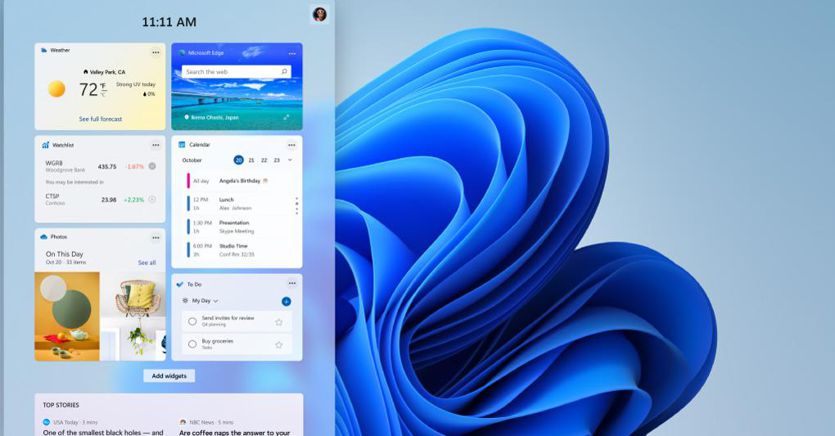“What’s Next for Windows”: the title chosen by Microsoft for the launch event of its new operating system is an excellent synthesis of the strategic thinking behind this highly anticipated update. Calling Windows 11 a “made in Redmond” software revolution is perhaps excessive, despite the great emphasis lavished by all of Microsoft’s top management, from CEO Satya Nadella (who used the expression “major milestone”) to the Chief Product Officer of Microsoft. a North American company, that Panos Panay who had the honor of opening the (virtual) works of the presentation conference and the burden of recounting all the merits of the new version in a long blog post. However, there is no doubt that the Microsoft engineers have worked in the round on the aesthetic and functional characteristics of the system, decisively taking the path of the versatility of the experience to be offered to users and consequently riding the logic of the multi-screen, of the computer that it is duplicated on different screens and in different environments and which must meet all the needs of collaboration, creativity, communication, productivity and entertainment of those who are using it.
Faster updates and more “beautiful” to use
After weeks of rumors and the “yellow” of the leak of a beta version removed from the Net a few days after its launch, Windows 11 therefore had its official baptism pending the actual availability, expected by the end of this year ( we’re talking about the end of November) with a free (and optional) update for eligible Windows 10 PCs. In the meantime, a sizeable series of beta releases are expected to be released starting next week for Insider Program members. Beyond the obvious steps forward in terms of pure performance (Windows Update updates will be up to 40% lighter and will run in the background, while also the system startup and navigation between the various applications promise an increase of important speed) and safety, what immediately stood out – respecting the anticipations of the eve – is the change of look.
Loading…
It starts from an installed base of 1.3 billion users
Windows 11 presents itself with a new and fresher aspect because Microsoft’s intention, as Nadella explained in her speech, is essentially to make its software a platform with all the tools needed to facilitate the task (and life ) of the user. Consumer or business. The challenge that brought the pandemic as a dowry is enormous: the computer market is back on track and for the software giant it is a unique opportunity to universally distil the capabilities of a system that is intended to mark this entire decade. Starting, and it should be remembered, from an installed base of about 1.3 billion users.
The main news in a nutshell
A completely redesigned interface that allows you to find the documents and applications you need faster, Snap Layouts to quickly reposition and organize windows and facilitate multitasking, Teams integration, a new Microsoft Store and the possibility to run Android apps natively. There are many, and even substantial, innovations in Windows 11 and starting from the last mentioned, the fact that the apps usually used on smartphones based on Google’s mobile software can be opened alongside other programs and work without particular limitations. . All thanks to a partnership with Amazon, which will make its store available for downloading apps, and in the wake of the vision of an “open” and interoperable Microsoft with other platforms that represents (with the cloud) Nadella’s operating creed. Microsoft has modernized the design and the user experience, as stated in the press release released by the company, starting from the new Start button, rightly defined as a cornerstone of Windows for at least 25 years now and positioned centrally on the taskbar as expected. Instead, the so-called “Tiles” introduced years ago with Windows 8 disappear, leaving room for a menu that focuses on recently used applications, documents and files. Widgets had also been talked about a lot in recent days and Windows 11 regularly shows off: it is a new personalized feed, enabled and updated by artificial intelligence, which allows you to view the most useful tasks and content for the user (from calendar to news) directly on your desktop. Finally, the “features” intended for video game enthusiasts, including the Auto Hdr and the Xbox app to access the titles on the Xbox Game Pass.
Skype leaves the scene, space for Teams
The integration of Teams directly into the application bar, which allows you to instantly connect with anyone on Windows, Android and iOS, is certainly the daughter of the Coronavirus and the boom in online activities, especially in the professional field. On the other hand, he points out that Skype (which Microsoft bought just ten years ago for 8.5 billion dollars) will leave the list of pre-installed applications on the devices produced by the company. The software for video calling once the most famous in the world (at the time of the acquisition it had 663 million registered users worldwide) can still be downloaded from the Store but it is de facto exited (fate that will definitely touch Internet Explorer in June 2022 ) in favor of the new messaging and videochat platform. Next generation Windows, precisely.
